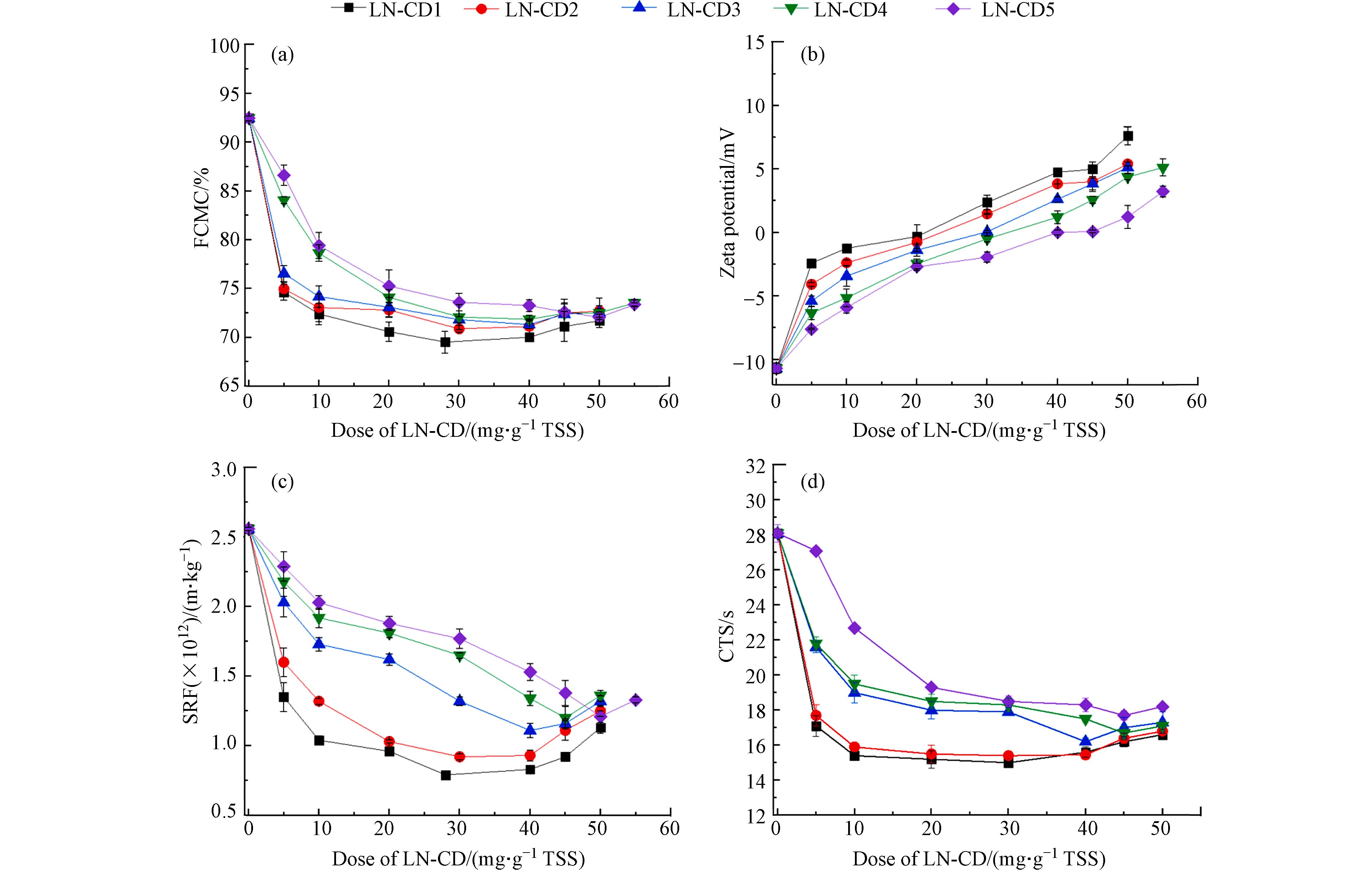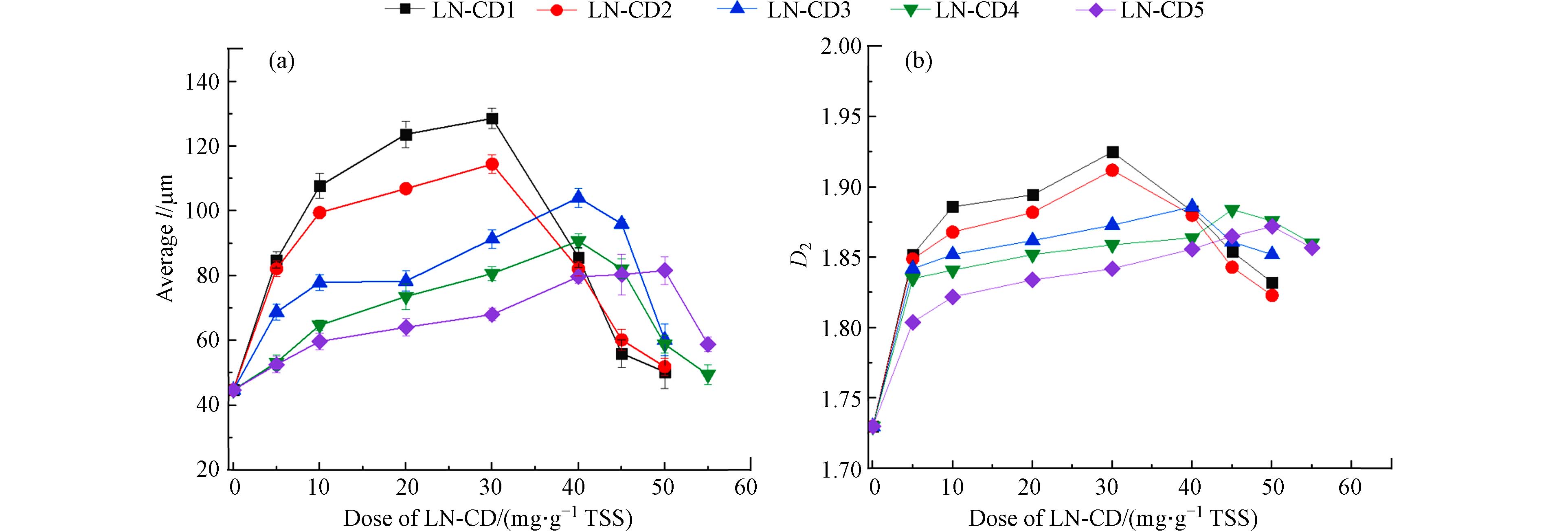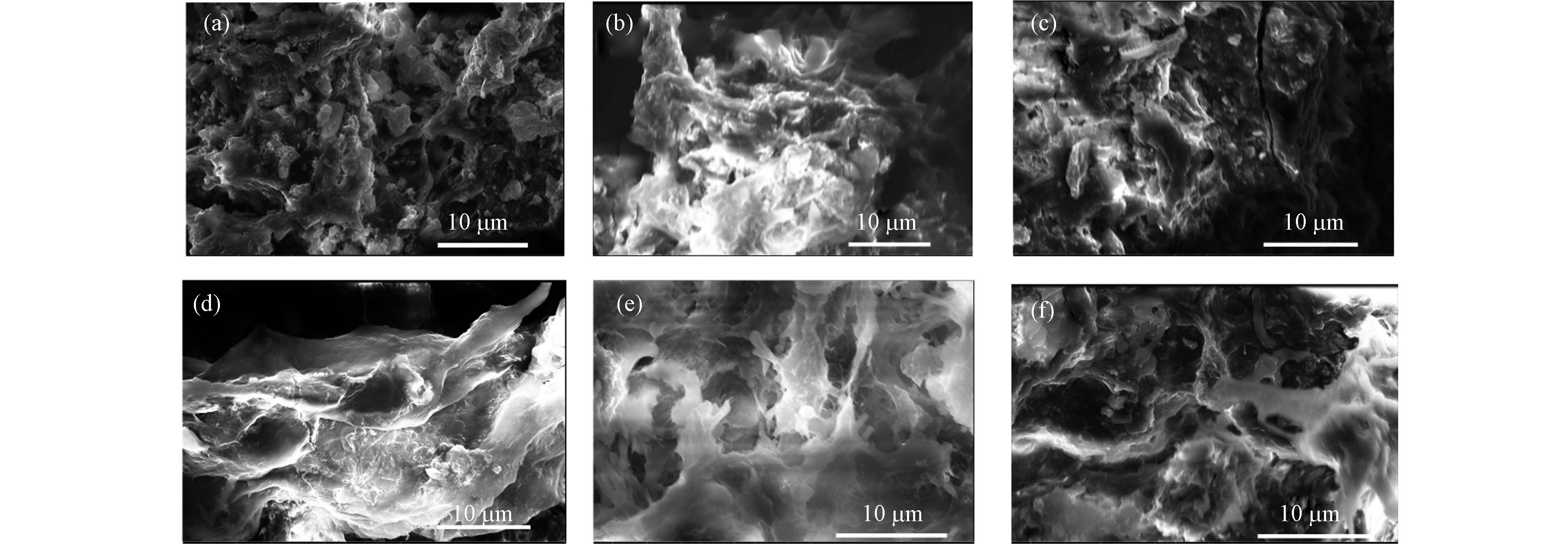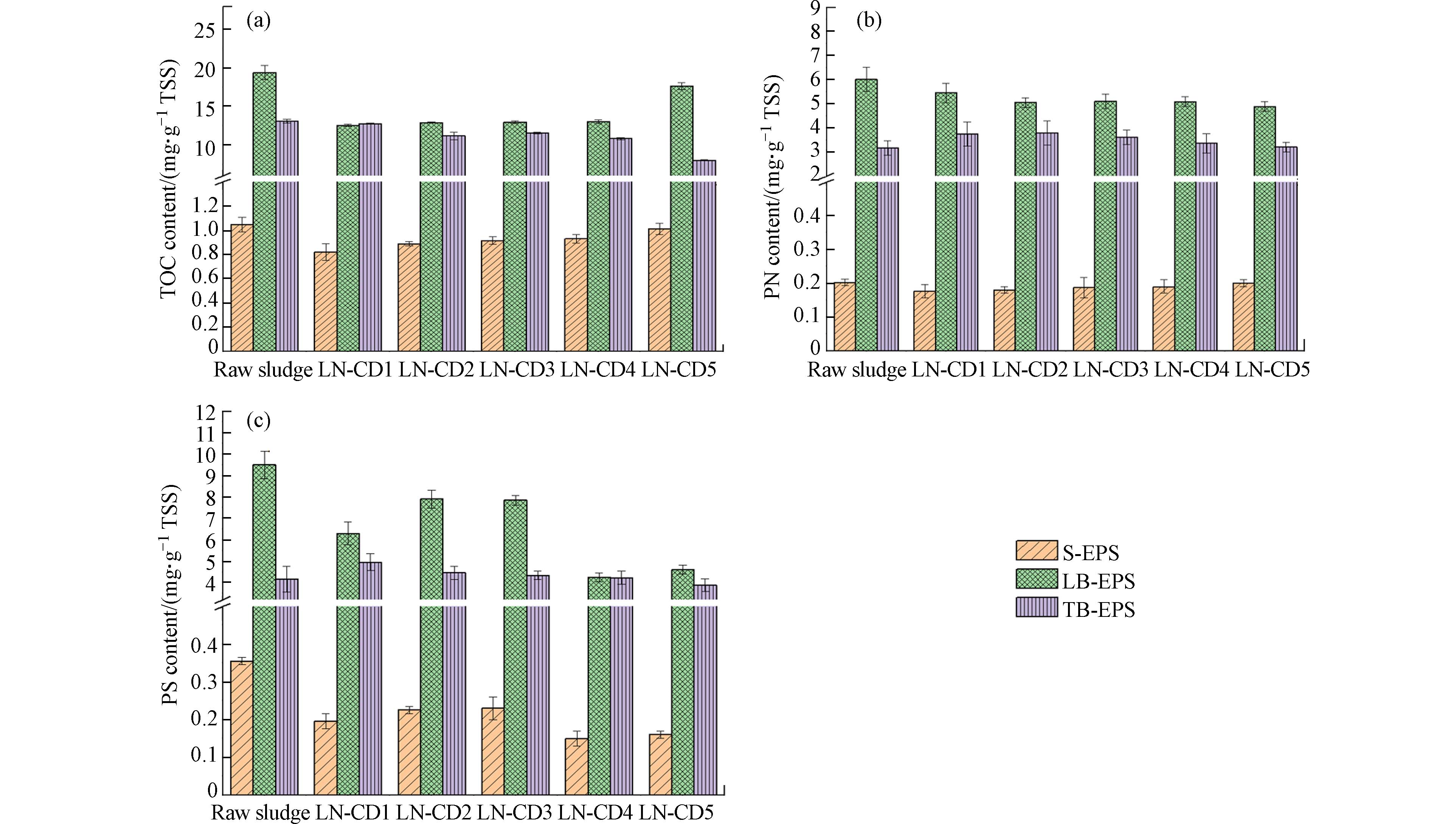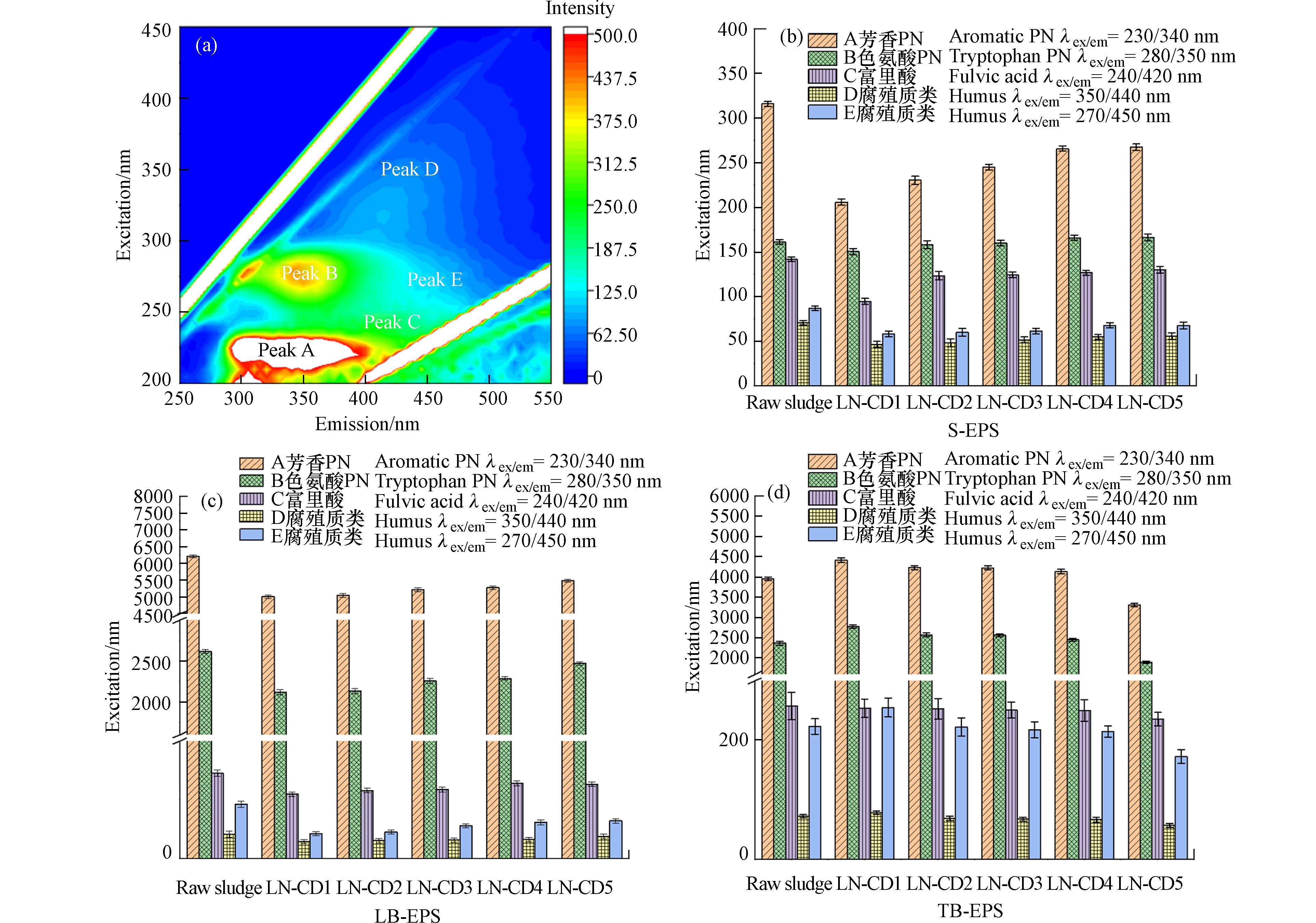-
污泥是常规水处理过程中的副产物,主要由微生物、胞外聚合物(EPS)、纤维和无机物质等组成,其处理处置在污水处理厂运营成本中占很大比例[1 − 2]. 污泥通常含有95%以上的水分[3 − 4],为了减少污泥体积,提高后处理效率并节约成本,有效实施泥水分离至关重要[3]. 然而由于污泥内亲水性EPS与部分水结合紧密,难以通过常规压滤及离心等机械作用完全去除,需要对污泥进行预处理调理[1,5].
污泥调理技术包括混凝、氧化、碱化、酸化、生物法等[6 − 10],其中混凝是一种常规污泥预处理技术,其操作简易,成本也低[11]. 目前常用的污泥调理混凝剂有聚丙烯酰胺和聚合氯化铝、氯化铁等铝铁盐无机混凝剂,它们普遍性价比高、处理效果佳[12]. 但是,上述传统混凝剂在使用时,高毒性有机单体和无机金属离子在水中不可避免地发生残留对水环境生态安全带来一定隐患[13 − 15]. 近年来,开发以木质素、淀粉、纤维素、单宁、壳聚糖等为代表的具有绿色环保等重要特征的天然高分子混凝剂已成为水处理行业中药剂研发的热点课题之一[16 − 20].
其中木质素是自然界中一类来源广泛且价格低廉的可再生资源,同时作为造纸制浆的副产品,每年产生约1.4亿t木质素黑液[21]. 然而由于缺乏有效的回收利用技术及应用途径,木质素目前尚未被完全有效利用[22]. 木质素化学结构复杂,其重复单元间缺乏规律,主要包括紫丁香基、对羟基苯基和愈创木基等三种苯丙烷结构单元[22],其详细分子结构至今尚未明确[23]. 但木质素含有丰富的易于改性的含氧功能基团,通过适当化学改性,其可制成混凝剂用于水处理[23 − 24]. Guo等[25]将二甲基二烯丙基氯化铵和丙烯酰胺(AM)通过接枝共聚技术链接到一种造纸污泥中提取的木质素上,获得一种阳离子木质素混凝剂,并发现该阳离子木质素混凝剂与聚合氯化铝联合使用能够实现废水中蓝色活性染料93%的去除率. 此外,还有报道将硫酸盐木质素与[2-(甲基丙烯氧基)乙基]三甲基氯化铵接枝反应生成木质素改性混凝剂[26],其在混凝高岭土悬浮液方面比单独使用聚([2-(甲基丙烯氧基)乙基]三甲基氯化铵)更为有效. 但是至今,将改性木质素混凝剂用于污泥调理的研究报道还不多[23,27]. 并且,木质素本身特有的刚性芳环结构不仅可起到骨料支撑作用,有利于改善泥饼可压缩性[28],同时其还可通过疏水缔合作用与EPS中疏水链片段结合有效压缩EPS,从而可进一步提高其污泥脱水性能. 此外,改性木质素除了具有污泥调理功能外,还可提高脱水后污泥的应用价值[21]. 由于木质素比生物污泥具有更高的热值,在焚烧处置时燃烧含木质素污泥比单独燃烧生物污泥可产生更高的能量. 因此,开发木质素基污泥调理剂具有重要的应用价值.
本文以木质素为原材,以AM和甲基丙烯酰氧乙基三甲基氯化铵(DMC)为改性单体,采用接枝共聚技术,制备一系列电荷密度(CD)不同的阳离子改性木质素混凝剂(LN-CD). 以南京仙林某市政污水处理厂活性污泥为研究对象,系统考察LN-CD污泥调理性能,具体检测了污泥调理后的泥饼含水率(FCMC)、污泥比阻(SRF)、毛细吸水时间(CST)和压缩系数(s)等;结合污泥絮体结构、泥饼表面形貌和EPS不同形态及成分含量与分布变化情况等,详细讨论了LN-CD混凝剂的污泥脱水机理. 为改性木质素混凝剂的开发及其在污泥脱水中的应用提供一定的理论参考及实验实践.
-
实验试剂:脱碱木质素(A.R.)、AM(A.R.)、DMC(A.R.)和聚乙烯硫酸钾(PVSK, A.R.)购于美国阿拉丁公司;牛血清蛋白(A.R.)、考马斯亮蓝G-250(A.R.)、葡萄糖(A.R.)、蒽酮(A.R.)、氯化十六烷基吡啶(A.R.)和甲苯胺蓝O(TBO,A.R.)购于国药集团化学试剂有限公司;丙酮(A.R.)、过硫酸铵(APS, A.R.)和乙醇(A.R.)购于上海凌峰化学试剂有限公司.
实验所用污泥为污泥浓缩池的活性污泥(WAS),来自南京仙林某市政污水处理厂,取回的活性污泥在4 ℃冰柜中储存,最长储存时间不超过5 d. 其污泥实际浓度为(15.0±0.6) g·L−1,pH为7.06±0.20,挥发性悬浮物与总悬浮物(TSS)比值为:43.0%±1.0%,溶解性化学需氧量:44—78 mg·L−1,电导率:(1.07±0.01) ms·cm−1;考虑到取泥时间及气候条件等差异,每批次污泥性质略有不同,为减少对后续测定污泥脱水效果的影响,实验中统一将污泥的含水率调节至98.50%. 此外,为减少实验误差,每组实验均采用同一批次污泥[19].
实验仪器:TA6-1程控混凝实验搅拌仪(武汉恒岭科技有限公司)、ZK82J电热真空干燥箱(上海实验仪器厂)、F3电导率仪(上海Mettler-Toledo有限公司)、DF-101SA集热式恒温加热磁力搅拌器(南京科尔有限公司)、Delta320pH计(瑞士Mettler-Toledo公司)、F-7000荧光分光光度计(日本日立公司)、400 mL超滤杯(山东博隆生物科技公司)、Multi N/C 3100总有机碳分析仪(美国OI Analytical公司)、LC-10N-80A冷冻干燥机(力辰仪器科技有限公司)、Nano-Z Zeta电位测定仪(英国Malvern公司)、XTL-3400光学显微镜(上海蔡康有限公司)、Quanta 250扫描电子显微镜(美国FEI公司).
-
称取2.0 g脱碱木质素溶解在40 mL蒸馏水中,用预先准备的NaOH溶液将pH调节为中性,待木质素完全溶解后倒入四颈烧瓶,水浴加热到70 ℃并不断搅拌,随后通氮气半小时. 排尽空气后,滴加5 mL质量分数为4 %的APS溶液作为引发剂. 再通氮气10 min后,通过恒压分液漏斗加入质量分数为80 %的接枝单体AM和DMC混合水溶液. 接枝反应完全后,采用无水乙醇将产物沉淀分离并洗涤脆化,最后在60 ℃下真空干燥48 h,经研磨后得到最终产物. 本实验合成的木质素改性混凝剂呈褐色粉末状,稳定性良好,在常温密闭干燥条件下储存. 控制AM和DMC总摩尔量恒定为0.06mol,通过调节两者摩尔投料比从0.5∶5.5增加到4∶2 (表1),共制得5种不同木质素改性混凝剂,并根据AM和DMC摩尔投料比由小到大 (0.5∶5.5—4∶2)依次命名为LN-CD1—LN-CD5(表1). LN-CD制备反应式参见图1.
-
对LN-CD进行傅里叶红外光谱(FTIR)及核磁共振氢谱(1H NMR)测定,检测样品分子结构. 红外光谱波数扫描范围为500—4000 cm−1; 核磁表征溶剂为D2O,共振频率为500 MHz. 采用胶体滴定法测定LN-CD系列混凝剂电荷密度,滴定剂为PVSK,指示剂为TBO[19].
-
室温下采用TA6-1程控混凝实验搅拌仪进行污泥混凝调理实验,在250 mL烧杯中加入100 mL污泥悬浊液,随后将新鲜配制的不同体积LN-CD溶液(浓度为15.0 g·L−1)加入污泥悬浊液中,在250 r·min−1下快速搅拌1.0 min,然后在50 r·min−1下缓慢搅拌5.0 min,最后静置10.0 min,每组实验均重复3次,最终结果为其平均值,实验相对误差均小于4%.
将调理后污泥进行脱水性能检测,包括FCMC、SRF、CST及s,上述参数均是评价污泥脱水性能的重要参数[29 − 31]. 其中,FCMC测定过程具体是:将调理后的污泥倒入装有0.45 µm孔径PVDF膜的压滤杯中,完全封闭后通入氮气,调节压力至0.4 MPa,在气压稳定后开始计时,直至时间为8.0 min或泥饼破裂为止. 取出泥饼,在105 ℃的烘箱中烘干至恒重. 根据公式(1)计算FCMC,其中m0为培养皿质量,m1与m2分别为烘干前后含泥饼培养皿质量.
SRF是将经混凝剂调理后的污泥在0.05 MPa压力下倒入含有0.45 µm微滤膜的布氏漏斗中抽滤进行测定[30]. 具体操作方法是:将抽滤所得滤液收集在一个100 mL量筒中,从开始抽滤计时,每隔5 s记录一次量筒读数,直到泥饼破裂或时间至6.0 min为止. SRF计算公式如公式(2),
其中,P(N·m−2)为抽滤压力; Sa(m2)为用于抽吸的滤纸面积;µ(N·s·m−2)为滤液的动力黏度;b(s·m−6)为滤液体积变化曲线斜率;ω(kg·m−3)为单位体积滤液所截留的固体质量.
使用英国Triton Electronics 304m型CST仪测量污泥CST,CST是反映污泥过滤性能的重要指标[31];此外,根据公式(3),在不同的压力条件下(0.02、0.03、0.04、0.05 MPa)测量污泥比阻,计算污泥压缩系数,评价泥饼的可压缩性能[32].
其中,SRF1和SRF2分别是抽滤压力为P1和P2时所得污泥比阻值,P2固定设定为0.02 MPa,P1为0.03、0.04、0.05 MPa,s为计算出的污泥压缩系数.
-
进一步测定污泥絮体特性,包括平均絮体尺寸(l)和二维分形维数(D2),以研究处理后污泥絮体微观结构变化[6,11]. 在固定放大倍数下,用配备有光学显微镜的Pentax K-m型数码相机对污泥絮体进行拍照,l反映污泥絮体特征长度,是连接物体轮廓两点并通过中心点的最长距离[11];通过图像分析软件(Image pro® Plus 6.0)测量污泥絮体l及投影面积(A),并通过公式(4)得到D2.
此外,在−60 ℃下冷冻干燥72 h,然后用扫描电子显微镜直接观察原始污泥和经不同混凝剂调理后污泥絮体以及泥饼的表面微观结构[33].
-
EPS主要分为可溶性EPS(S-EPS)、松散结合型EPS(LB-EPS)和紧密结合型EPS(TB-EPS) [11],采用改良的超声波热萃取法进行EPS提取[34]. 操作方法如下:首先将10 mL污泥在试管中以3000 r·min−1离心10.0 min,然后提取上清液并通过0.45 μm滤膜过滤,得到S-EPS;将剩余污泥用质量分数为0.05%的NaCl溶液重新定容到10 mL,然后以20 kHz超声处理2 min,在摇床中以150 r·min−1震荡10.0 min,再以20 kHz超声处理2.0 min,接着在以5000 r·min−1离心10.0 min,提取上清液并通过0.45 μm滤膜过滤,得到LB-EPS;最后,将剩余污泥用质量分数为0.05%NaCl溶液重新定容至10 mL,然后以20 kHz超声处理3.0 min,60℃水浴中加热30.0 min,接着在试管中以8000 r·min−1离心10.0 min,提取上清液并通过0.45 μm滤膜过滤,得到TB-EPS.
对于提取后的污泥EPS,使用总有机碳(TOC)分析仪,采用差减法测定各EPS的TOC含量. 使用F-7000荧光分光光度计,测量EPS组分的三维荧光(3D-EEM)光谱. EPS中蛋白质(PN)采用考马斯亮蓝法[35]检测分析,以牛血清蛋白为标样绘制标准曲线,加入考马斯亮蓝蛋白试剂,在595 nm波长下比色检测并计算PN含量. 采用蒽酮比色法[36]检测分析EPS中多糖(PS)含量,采用葡萄糖标准溶液绘制标准曲线,溶液中加入蒽酮试剂,在625 nm波长下比色测定吸光度,计算PS含量.
-
使用IBM SPSS Statistics 22.0版中的Pearson相关系数计算软件,对数据进行相关性分析,主要考察FCMC或SRF值与污泥中EPS中不同组分间的相关性[37],综合分析LN-CD混凝剂污泥脱水机理.
-
以木质素为原材,根据图1,通过调节AM和DMC两种共聚单体摩尔投料比(表1),共制得5种不同改性木质素混凝剂. 木质素及LN-CD系列样品的FTIR和1H NMR谱图见图2. 根据图2a, 与木质素红外图谱相比,LN-CD系列样品在1720、1667、1480、957 cm−1处出现了新的特征峰. 在1720 cm−1出现的强特征峰是DMC侧链上羰基C=O的伸缩振动吸收峰[38],在1480 cm−1和957 cm−1的特征峰归属于DMC单体上—N(CH3)3和C—H键[39];在1667 cm−1处的峰为AM上—CONH2上羰基特征峰[40], 说明AM和DMC均已成功接枝到木质素的分子骨架上. 在图2b中,和木质素1H NMR谱图相比,LN-CD系列样品在化学位移为3.20 ppm左右处出现新的特征峰,归属于DMC季铵基团上的甲基质子[38],在4.60—4.80 ppm出现了木质素的质子特征峰. DMC基团的红外及核磁特征峰峰强均随DMC投加量(表1)增加而增强(图2),因此,红外及核磁表征结果均表明AM和DMC已成功接枝到木质素上. 由于5种不同改性木质素混凝剂产率均 >90%,AM和DMC两种共聚单体均已接枝到木质素分子链上,两种共聚单体总摩尔量一致,引发剂APS用量也相等,可以近似认为5种LN-CD样品具有相似的接枝链长度以及接枝链分布[34],但CD值不同,根据表1,其CD值随着阳离子单体DMC用量的增加而增大.
-
将LN-CD应用于污泥调理,图3为不同LN-CD样品调理后污泥FCMC、SRF、CST和上清液zeta电位随混凝剂投加量增加的变化趋势图.
随着投加量的增加,LN-CD样品调理后污泥的SRF、CST和FCMC均呈现先快速下降达到最佳值后逐步趋于平缓的趋势,而当混凝剂过量时,则会略有上升. 不同LN-CD混凝剂最佳投加量及该条件下FCMC、SRF、CST与zeta电位值均列于表1中. 根据表1,经CD值较大的LN-CD1和LN-CD2调理后污泥的FCMC、SRF和CST下降更为明显,而最佳投加量却最低,约为30 mg·g−1 TSS左右. 这是由于LN-CD上含有大量阳离子基团,与表面带负电性的污泥颗粒发生电中和作用[39],导致污泥颗粒脱稳团聚,并且LN-CD大分子长链结构可通过粘结架桥作用进一步促进污泥初级絮体聚集,导致FCMC、SRF和CST快速下降[34]. 此外,木质素的刚性芳环结构也起到了骨料作用,使得泥饼的渗透性得到有效提高. 根据图3,经混凝剂调理后,污泥上清液的zeta电位随混凝剂投加量增加而明显升高. 在最佳投加量下,上清液的zeta电位接近0(表1),说明混凝过程中带正电的混凝剂与表面带负电的污泥胶体颗粒间发生了完全电中和作用,LN-CD主要依从简单电中和机制;过量混凝剂条件下引起的污泥脱水性能下降,是由于污泥絮体表面逐渐带有正电荷,发生再稳效应造成的,这与前人研究报道一致[34,41].
-
根据表1,在制备LN-CD系列样品过程中,保持两种共聚单体AM和DMC总物质量不变,从LN-CD1到LN-CD5,随着阳离子单体DMC用量的减少,LN-CD样品CD随之下降,其CD从LN-CD1的3.87 mmol·g−1降至LN-CD5的1.56 mmol·g−1. 根据图3及表1,在LN-CD1—LN-CD5样品中,CD越大,污泥脱水效果越佳,且最佳投加量越低;最佳投加量下,经CD最大的LN-CD1调理后的污泥 FCMC最低可达69.51%,而SRF及CST分别降至0.79×1012 m·kg−1与15.0 s,进一步佐证LN-CD电中和机制在污泥调理中的重要作用,CD比例越大,电中和效率越高,污泥脱水性能越显著[42].
-
除了上述表观脱水性能外,对使用不同剂量LN-CD进行调理的污泥絮体性质,包括平均絮体尺寸(l) [43]和二维分型维数(D2) [6,11,44],分别进行了检测,结果如图4所示. 根据图4a及4b,随着LN-CD投加量的增加,污泥絮体尺寸及二维分型维数均先逐渐增加,当到达混凝剂最佳投加量时,l及D2达到最大值,随着混凝剂投加量进一步增大,l与D2逐渐下降. 这一结果与其表观污泥脱水性能一致,最佳条件下获得的污泥絮体尺寸最大且絮体结构也最为密实,有利于进一步机械压滤成饼,高效脱水;而过量条件下,絮体性质变差是由再稳定效应引起的[11,34].
将最佳投加量下不同LN-CD调理后测定的l及D2列于表1中. 根据表1,不同电荷密度LN-CD样品相比,CD越大,最佳投加量条件下,l与D2越大. 其中CD最大LN-CD1样品最佳条件下,l与D2最大,分别为128 µm及1.92. 上述结果进一步说明LN-CD电中和混凝机制在其污泥脱水中的重要作用. 此外,通过SEM直接观察LN-CD最佳投加量下污泥絮体和泥饼的表面形貌(图5),原泥絮体结构松散,表面存在细小孔洞(图5a),而经混凝剂(分别以CD最高和最低的LN-CD1和LN-CD5为代表)调理后获得的污泥絮体均更加密实(图5b及5c),有利于随后压滤成饼. 图5d显示原泥泥饼表面光滑,没有明显孔道,分别经LN-CD1和LN-CD5调理后的泥饼表面粗糙多孔,其微观结构有利于压滤排水(图5e及5f). 为了进一步考察泥饼的可压缩性,在LN-CD最佳投加量下测定其压缩系数,并列于表1中. 根据表1,泥饼压缩系数随着LN-CD电荷密度增大而下降,其可压缩性得以改善,证明增加混凝剂CD有利于改善泥饼可压缩性,这一结果与其絮体性质及表观污泥脱水性能一致. 此外,除了电中和作用,LN-CD混凝剂中木质素的刚性芳环结构作为骨料,可在随后压缩成饼中形成稳定排水通道,提高泥饼的可渗透性,从而进一步提高污泥脱水性能[32].
-
EPS是影响污泥脱水效率的主要因素之一[6,45 − 46]. 本文进一步考察了不同CD的LN-CD混凝剂在各自最佳投加量下(参见表1)进行污泥调理后,对EPS不同形态(S-EPS, LB-EPS及TB-EPS)中TOC、PN与PS)含量变化的影响,根据图6a,与原泥相比,经不同LN-CD调理后,污泥中S-EPS和LB-EPS的TOC含量均明显下降,而TB-EPS变化不明显.
特别是S-EPS,随着LN-CD电荷密度的增加,其TOC含量下降越为显著. 这一结果说明,该阳离子木质素混凝剂通过电中和作用有效抑制污泥中EPS,特别是S-EPS,从而提高其污泥脱水性能[11,34,41]. 图6b及6c中显示不同形态EPS中主要成分PN与PS[46]经不同LN-CD调理后,其含量变化与不同形态EPS中TOC含量变化趋势大体一致,S-EPS和LB-EPS中PN与PS含量相比于原泥,均有所下降,而TB-EPS中PN与PS含量变化并不显著,甚至略有上升. 这可能是由于阳离子木质素混凝剂抑制不同形态EPS过程中,部分S-EPS和LB-EPS转化为TB-EPS[43]. 此外,上述结果也说明LN-CD主要通过抑制污泥中S-EPS和LB-EPS,促进污泥脱水.
-
除了PN与PS,EPS中还包含腐殖质、富里酸等其他有机成分[42 − 43,46]. 为了进一步探究不同EPS组分在混凝调理中的变化情况,对经不同LN-CD最佳投加量下调理后污泥中不同形态EPS进行3D-EEM光谱检测,如图7所示. 根据文献[47 − 48],污泥EPS的3D-EEM光谱可大致分为5个区域(图7a),包括芳香族PN(λex/em= 230/340 nm,峰A)、色氨酸类PN(λex/em= 280/350 nm,峰B)、富里酸(λex/em= 240/420 nm,峰C)以及腐殖质类物质(λex/em= 350/440 nm和270/450 nm,峰D和E).
根据图7b, 7c及7d,经LN-CD调理后,S-EPS和LB-EPS中的5个组分对应特征峰强度均有所下降,且大致随着LN-CD电荷密度增加而对应特征峰峰强下降越为明显;TB-EPS中的不同组分对应特征峰强度变化并不显著,甚至略有上升,结果与图6中不同形态EPS中TOC及PN与PS含量变化一致. 其中,不同形态EPS中芳香族PN(峰A)随不同电荷密度LN-CD混凝剂调理后变化最为明显,LN-CD电荷密度越大,其峰值降低趋势越为显著,这可能是由于除了电中和作用外,LN-CD中木质素的芳环结构与芳香族PN存在着结构相似性,有利于其通过疏水缔合作用结合并对EPS有效抑制,这一结果与图6b中不同形态EPS中PN含量变化一致,且对应混凝剂调理后污泥的脱水性能越佳(图3),进一步佐证EPS中PN含量与实际污泥脱水性能相关[49 − 51];富里酸(峰C)以及腐殖质类物质(峰D和E)峰值随LN-CD电荷密度变化不明显,说明EPS中腐殖质类物质对污泥脱水性能影响不大[52].
为了进一步探究EPS对污泥脱水性能的影响及LN-CD混凝剂污泥脱水机制,对其调理后实际污泥脱水性能(以FCMC和SRF为代表, 图3a和3c)与对应EPS不同形态及组成含量(图6及图7)进行Pearson相关性分析[37],结果列于表2. 根据表2,S-EPS组分中TOC及PN含量(包括芳香族PN及色氨酸类PN)与污泥的脱水性能存在着较强正相关性(P < 0.05),TB-EPS的不同组分含量则与脱水性能成负相关性,结果进一步表明EPS中S-EPS,特别是PN组分含量,与污泥脱水性能密切相关[53-54].
-
本论文研究发现电荷密度是影响LN-CD污泥脱水性能的关键结构参数,在本工作研究范围内,CD越大脱水效果越佳,其中经CD最高的LN-CD1在最佳投加量下调理后,污泥FCMC、SRF、CST和s分别从98.50%、2.56×1012 m·kg−1、28.10 s及1.24,下降为:68.91%、0.89×1012 m·kg−1、15.00 s及0.81;且获得的污泥絮体尺寸最大( l为128 µm)结构也最为紧密(D2为1.92);因此电中和作用是LN-CD污泥脱水的主要作用机理. 此外,由于木质素本身特有的芳环结构不仅可起到骨料支撑作用有利于改善泥饼可压缩性,增强其泥饼渗透性,同时其疏水性能还可通过疏水缔合作用与EPS中疏水片段(如芳香族PN)结合有效压缩EPS;并且木质素特有的大分子结构还赋予LN-CD混凝剂良好的粘结架桥絮凝作用,在上述效应共同作用下,进一步提高其污泥脱水性能. 根据对污泥调理过程中,EPS不同形态及成分含量与分布变化情况分析,LN-CD能有效抑制S-EPS和LB-EPS;Pearson相关性分析结果表明,S-EPS组分中TOC及PN含量(包括芳香族PN及色氨酸类PN)与污泥的脱水性能存在较强正相关性(P < 0.05),而TB-EPS的不同组分含量则与脱水性能成负相关性,上述结果进一步表明EPS中S-EPS,特别是PN组分含量,是影响污泥脱水性能的重要因素. 总而言之,尽管LN-CD污泥脱水性能及相关微观机制还需进一步更为深入的研究与探讨,但由于兼具绿色高效的特征,其在污泥脱水中应用前景广阔.
阳离子改性木质素混凝剂污泥脱水性能研究
Sludge dewatering performance of a cationically modified lignin coagulant
-
摘要: 混凝调理是一种成本低廉、操作方便的污泥调理方法. 而传统无机盐混凝剂和合成有机高分子混凝剂在使用过程中存在金属离子及高毒性单体残留等问题. 本文以自然界中来源广泛的一种可再生资源——木质素为原材,以丙烯酰胺和甲基丙烯酰氧乙基三甲基氯化铵为改性单体,采用接枝共聚技术,制得一系列电荷密度(CD)不同的阳离子改性木质素混凝剂(LN-CD). 以南京仙林某市政污水处理厂活性污泥为研究对象,测定了活性污泥经系列LN-CD调理后的泥饼含水率(FCMC)、污泥比阻(SRF)、毛细吸水时间(CST)和压缩系数(s),系统考察了LN-CD污泥调理性能;结合污泥絮体结构、泥饼表面形貌和污泥中胞外聚合物(EPS)不同形态及成分含量与分布变化情况,详细讨论了LN-CD混凝剂的污泥脱水机理. 研究结果表明,LN-CD具有良好的污泥调理效果,CD是影响LN-CD脱水性能的重要因素,CD越高污泥脱水效果越佳,其中经CD最高的LN-CD1调理后,FCMC、SRF、CST和s分别为:68.91%、0.89×1012 m·kg−1、15.0 s及0.81;且获得的污泥絮体尺寸最大结构也最为紧密,污泥中不同形态EPS含量及蛋白质与多糖组分也均有效下降. 这是由于LN-CD通过电中和及粘结架桥作用有效聚集污泥颗粒,对EPS结构造成破坏,释放出结合水;此外,木质素本身特有的芳环结构不仅可利用其刚性结构特征起到骨料支撑作用有利于改善泥饼可压缩性,增强其泥饼渗透性,同时其疏水性能还可通过疏水缔合作用与EPS中疏水片段结合有效压缩EPS,从而进一步提高其污泥脱水性能. 综上所述,LN-CD制备简单,绿色环保,污泥调理性能优良,其在污泥脱水中应具有良好的应用前景.
-
关键词:
- 阳离子改性木质素混凝剂 /
- 电荷密度 /
- 污泥脱水性能 /
- 胞外聚合物 /
- 脱水机制
Abstract: Coagulation conditioning is a sludge pretreatment method with the characteristics of low cost and simple operation. However, the traditional inorganic salt coagulants and synthetic organic polymeric coagulants may have some serious potentials in health risks and cause some environmental problems due to their residues of metal ions and toxic organic monomers in practical applications. Lignin is a kind of renewable resources widely available in nature. In this paper, a series of cationically modified lignin-based coagulants (LN-CD) with different charge density (CD) were prepared by grafting copolymerization using lignin as raw material while acrylamide and methacryloxyethyl trimethyl ammonium chloride as co-monomers. The activated sludge obtained from a municipal sewage plant at Xianlin of Nanjing was used as the target. The filter cake moisture content (FCMC), specific resistance of filtration (SRF), time to filter (CST) and compression coefficient (s) of sludge after conditioned by various LN-CD coagulants were determined. The dewatering mechanisms of LN-CD were discussed in detail by combination of the apparent dewatering performance and the changes in the contents and distributions of the extracellular polymeric substance (EPS) fractions and components, sludge flocs, and microstructures of sludge cakes. The results show that LN-CD has a good dewatering performance, and the CD is an important structural factor of this lignin-based coagulant. Generally, the higher the CD is, the better the sludge dewatering performance is obtained. After the conditioning of LN-CD1 with the highest CD in this series of lignin-based coagulants, FCMC, SRF, CST and s reach to 68.91%, 0.89×1012 m·kg−1, 15.0 s and 0.81, respectively; the obtained sludge floc also showed the largest size and the most compact structure; and the contents of different EPS fractions and their components including protein and polysaccharide in sludge were effectively reduced also. These findings are ascribed to that LN-CD can effectively aggregate sludge particles through charge neutralization and bridging effects, compress and destroy EPS structure, and thus release the bound water. In addition, the unique aromatic ring structure of lignin can play the role of skeleton builder due to its rigid structural characteristics, which is conducive to the improved compressibility and permeability of sludge cakes; besides, its partially hydrophobic property can combine the hydrophobic fragments in EPS and effectively compress EPS through the hydrophobic association, further improving the dewatering performance. In summary, LN-CD has the advantages of simple preparation, environmental friendliness, good sludge dewatering performance, and thus exhibits a good application prospects in sludge treatment. -
图 5 污泥原泥及经不同LN-CD在最佳投加量条件下污泥絮体及泥饼的扫描电镜图像(a)原泥絮体、分别经(b)LN-CD1及(c)LN-CD5调理后絮体; (d)原泥泥饼、分别经(e)LN-CD1及(f)LN-CD5调理后泥饼
Figure 5. SEM images of raw sludge flocs and sludge cakes conditioned by various LN-CDs under optimal dosages: (a) raw sludge flocs, flocs obtained by (b) LN-CD1 and (c) LN-CD5; (d) raw sludge cakes, sludge cakes by (e) LN-CD1 and (f) LN-CD5
表 1 LN-CD混凝剂制备条件、结构参数及其最佳投加量条件下脱水效果和污泥絮体特性
Table 1. Preparation conditions and structural characteristics of various LN-CD coagulants, and their dewatering performance and flocs properties under the optimal dosages
混凝剂Coagulant AM : DMC 摩尔比 电荷密度/(mmol·g−1)CD 最佳投加量/(mg·g−1 TSS)Optimal dosage 泥饼含水率/%FCMC 污泥比阻(×1012)/(m·kg−1)SRF 毛细吸水时间/sTime tofilterCST 压缩系数Compression coefficients zeta电位/mVZeta potential 平均絮体粒径/µmAverage particle size 二维分型维数Two-dimensional fractal dimensionD2 原泥 — — — 98.50±0.25 2.56±0.10 28.10±0.50 1.24±0.02 -8.85±0.42 44.72±1.32 1.73±0.03 LN-CD1 0.5 : 5.5 2.69 28 69.51±0.26 0.79±0.12 15.00±0.25 0.81±0.02 -0.34±0.02 128.59±0.17 1.92±0.01 LN-CD2 1 : 5 2.32 30 70.87±0.73 0.92±0.06 15.40±0.12 0.82±0.01 -0.31±0.03 114.48±1.14 1.91±0.02 LN-CD3 2 : 4 2.27 40 71.32±1.12 1.11±0.16 16.20±0.31 0.90±0.03 -1.05±0.08 104.06±0.38 1.89±0.01 LN-CD4 3 : 3 2.07 45 71.83±0.68 1.17±0.03 16.70±0.42 0.89±0.02 -0.96±0.04 82.12±0.04 1.88±0.02 LN-CD5 4 : 2 1.61 50 72.05±0.54 1.21±0.11 17.70±0.14 0.97±0.03 -1.19±0.08 80.37±0.62 1.87±0.01 表 2 污泥脱水性能与PN、PS和TOC含量或不同EPS组分中各种三维荧光信号的强度之间的Pearson相关关系
Table 2. Pearson correlation between the sludge dewaterability and the PN, PS and TOC contents or the intensities of various 3D fluorescent signals in different EPS fractions
EPS组分EPS fractions EPS成分EPS components 污泥比阻SRF 泥饼含水率FCMC R2 p n R2 p n S-EPS TOC 0.894* 0.041 5 0.929* 0.022 5 PS −0.528 0.361 5 −0.447 0.450 5 PN 0.905* 0.035 5 0.880* 0.049 5 λex/em 230/340 0.986** 0.002 5 0.984** 0.002 5 280/350 0.965** 0.008 5 0.991** 0.001 5 240/420 0.855 0.065 5 0.953* 0.012 5 350/440 0.978** 0.004 5 0.930* 0.022 5 270/450 0.912* 0.031 5 0.890* 0.043 5 LB-EPS TOC 0.564 0.322 5 0.592 0.293 5 PS −0.546 0.341 5 −0.453 0.443 5 PN 0.785* 0.016 5 0.909* 0.032 5 λex/em 230/340 0.904* 0.035 5 0.865 0.058 5 280/350 0.866 0.058 5 0.828 0.083 5 240/420 0.942* 0.017 5 0.937* 0.019 5 350/440 0.769 0.129 5 0.788 0.114 5 270/450 0.983** 0.003 5 0.924* 0.025 5 TB-EPS TOC −0.735 0.157 5 −0.801 0.104 5 PS −0.919* 0.027 5 −0.969** 0.007 5 PN −0.869 0.056 5 −0.803 0.102 5 λex/em 230/340 −0.667 0.218 5 −0.703 0.185 5 280/350 −0.746 0.147 5 −0.785 0.116 5 240/420 −0.657 0.228 5 −0.667 0.219 5 350/440 −0.858 0.063 5 −0.922* 0.026 5 270/450 −0.831 0.081 5 −0.891* 0.042 5 * Correlation is significant at the 0.05 level (2-tailed). ** Correlation is significant at the 0.01 level (2-tailed). -
[1] CAO B D, ZHANG T, ZHANG W J, et al. Enhanced technology based for sewage sludge deep dewatering: A critical review[J]. Water Research, 2021, 189: 116650. doi: 10.1016/j.watres.2020.116650 [2] WU B R, DAI X H, CHAI X L. Critical review on dewatering of sewage sludge: Influential mechanism, conditioning technologies and implications to sludge re-utilizations[J]. Water Research, 2020, 180: 115912. doi: 10.1016/j.watres.2020.115912 [3] ZHANG X D, YE P, WU Y J. Enhanced technology for sewage sludge advanced dewatering from an engineering practice perspective: A review[J]. Journal of Environmental Management, 2022, 321: 115938. doi: 10.1016/j.jenvman.2022.115938 [4] MOWLA D, TRAN H N, ALLEN D G. A review of the properties of biosludge and its relevance to enhanced dewatering processes[J]. Biomass and Bioenergy, 2013, 58: 365-378. doi: 10.1016/j.biombioe.2013.09.002 [5] LI X Y, YANG S F. Influence of loosely bound extracellular polymeric substances (EPS) on the flocculation, sedimentation and dewaterability of activated sludge[J]. Water Research, 2007, 41(5): 1022-1030. doi: 10.1016/j.watres.2006.06.037 [6] TURCHIULI C, FARGUES C. Influence of structural properties of alum and ferric flocs on sludge dewaterability[J]. Chemical Engineering Journal, 2004, 103(1/2/3): 123-131. [7] YU W B, YANG J K, SHI Y F, et al. Roles of iron species and pH optimization on sewage sludge conditioning with Fenton’s reagent and lime[J]. Water Research, 2016, 95: 124-133. doi: 10.1016/j.watres.2016.03.016 [8] LI H, JIN Y Y, MAHAR R, et al. Effects and model of alkaline waste activated sludge treatment[J]. Bioresource Technology, 2008, 99(11): 5140-5144. doi: 10.1016/j.biortech.2007.09.019 [9] MASIHI H, BADALIANS GHOLIKANDI G. Using acidic-modified bentonite for anaerobically digested sludge conditioning and dewatering[J]. Chemosphere, 2020, 241: 125096. doi: 10.1016/j.chemosphere.2019.125096 [10] LÜ F, WANG J W, SHAO L M, et al. Enzyme disintegration with spatial resolution reveals different distributions of sludge extracellular polymer substances[J]. Biotechnology for Biofuels, 2016, 9: 29. doi: 10.1186/s13068-016-0444-y [11] WEI H, GAO B Q, REN J, et al. Coagulation/flocculation in dewatering of sludge: A review[J]. Water Research, 2018, 143: 608-631. doi: 10.1016/j.watres.2018.07.029 [12] MATILAINEN A, VEPSÄLÄINEN M, SILLANPÄÄ M. Natural organic matter removal by coagulation during drinking water treatment: A review[J]. Advances in Colloid and Interface Science, 2010, 159(2): 189-197. doi: 10.1016/j.cis.2010.06.007 [13] BOLTO B, GREGORY J. Organic polyelectrolytes in water treatment[J]. Water Research, 2007, 41(11): 2301-2324. doi: 10.1016/j.watres.2007.03.012 [14] OKUDA T, NISHIJIMA W, SUGIMOTO M, et al. Removal of coagulant aluminum from water treatment residuals by acid[J]. Water Research, 2014, 60: 75-81. doi: 10.1016/j.watres.2014.04.041 [15] STECHEMESSER B, DOBIAS B. Coagulation and Flocculation, second ed [M]. CRC Press, 2005. [16] LIU Y Z, ZHENG H L, SUN Y J, et al. Synthesis of novel chitosan-based flocculants with amphiphilic structure and its application in sludge dewatering: Role of hydrophobic groups[J]. Journal of Cleaner Production, 2020, 249: 119350. doi: 10.1016/j.jclepro.2019.119350 [17] CHEN R J, DAI X H, DONG B. Decrease the effective temperature of hydrothermal treatment for sewage sludge deep dewatering: Mechanistic of tannic acid aided[J]. Water Research, 2022, 217: 118450. doi: 10.1016/j.watres.2022.118450 [18] LIU Z Z, HUANG M, LI A M, et al. Flocculation and antimicrobial properties of a cationized starch[J]. Water Research, 2017, 119: 57-66. doi: 10.1016/j.watres.2017.04.043 [19] 陈炜, 沈少航, 闵广宇, 等. 接枝型阳离子淀粉絮凝剂在污泥脱水中的应用与机理研究[J]. 环境化学, 2021, 40(7): 2217-2225. doi: 10.7524/j.issn.0254-6108.2020111701 CHEN W, SHEN S H, MIN G Y, et al. Application and mechanism of a graft cationic starch-based flocculant in sludge dewatering[J]. Environmental Chemistry, 2021, 40(7): 2217-2225 (in Chinese). doi: 10.7524/j.issn.0254-6108.2020111701
[20] 余伟, 黄牧, 李爱民, 等. 多功能型天然高分子水处理剂的研究[J]. 环境化学, 2018, 37(6): 1293-1310. doi: 10.7524/j.issn.0254-6108.2017091302 YU W, HUANG M, LI A M, et al. Multi-functional natural polymer based water treatment agents[J]. Environmental Chemistry, 2018, 37(6): 1293-1310 (in Chinese). doi: 10.7524/j.issn.0254-6108.2017091302
[21] GHAZISAIDI H, WANG V, FATEHI P, et al. Determining the performance of lignin-based flocculants in improving biosludge dewaterability[J]. Journal of Environmental Management, 2023, 325: 116509. doi: 10.1016/j.jenvman.2022.116509 [22] WANG B, WANG S F, LAM S S, et al. A review on production of lignin-based flocculants: Sustainable feedstock and low carbon footprint applications[J]. Renewable and Sustainable Energy Reviews, 2020, 134: 110384. doi: 10.1016/j.rser.2020.110384 [23] CHIO C, SAIN M, QIN W S. Lignin utilization: A review of lignin depolymerization from various aspects[J]. Renewable and Sustainable Energy Reviews, 2019, 107: 232-249. doi: 10.1016/j.rser.2019.03.008 [24] KAI D, TAN M J, CHEE P L, et al. Towards lignin-based functional materials in a sustainable world[J]. Green Chemistry, 2016, 18(5): 1175-1200. doi: 10.1039/C5GC02616D [25] GUO K Y, GAO B Y, LI R H, et al. Flocculation performance of lignin-based flocculant during reactive blue dye removal: Comparison with commercial flocculants[J]. Environmental Science and Pollution Research, 2018, 25(3): 2083-2095. doi: 10.1007/s11356-017-0835-z [26] WANG S J, KONG F G, GAO W J, et al. Novel process for generating cationic lignin based flocculant[J]. Industrial & Engineering Chemistry Research, 2018, 57(19): 6595-6608. [27] HASAN A, FATEHI P. Cationic kraft lignin-acrylamide copolymer as a flocculant for clay suspensions: (2) Charge density effect[J]. Separation and Purification Technology, 2019, 210: 963-972. doi: 10.1016/j.seppur.2018.08.067 [28] WANG S Q, CHEN H B. Enhanced dewaterability of sewage sludge by grafted cationic lignin-based flocculants[J]. Science of the Total Environment, 2023, 903: 166958. doi: 10.1016/j.scitotenv.2023.166958 [29] APHA. Standard methods for the examination of water and wastewater, twentiethed [M]. American Public Health Association, Washington DC, USA, 1998. [30] CHEN Z, ZHANG W J, WANG D S, et al. Enhancement of activated sludge dewatering performance by combined composite enzymatic lysis and chemical re-flocculation with inorganic coagulants: Kinetics of enzymatic reaction and re-flocculation morphology[J]. Water Research, 2015, 83: 367-376. doi: 10.1016/j.watres.2015.06.026 [31] CHEN G W, LIN W W, LEE D J. Capillary suction time (CST) as a measure of sludge dewaterability[J]. Water Science and Technology, 1996, 34(3/4): 443-448. [32] GUO J Y, JIANG S L, PANG Y J. Rice straw biochar modified by aluminum chloride enhances the dewatering of the sludge from municipal sewage treatment plant[J]. Science of the Total Environment, 2019, 654: 338-344. doi: 10.1016/j.scitotenv.2018.10.429 [33] CHEN G H, SABY S, DJAFER M, et al. New approaches to minimize excess sludge in activated sludge systems[J]. Water Science and Technology:a Journal of the International Association on Water Pollution Research, 2001, 44(10): 203-208. doi: 10.2166/wst.2001.0621 [34] HU P, ZHUANG S H, SHEN S H, et al. Dewaterability of sewage sludge conditioned with a graft cationic starch-based flocculant: Role of structural characteristics of flocculant[J]. Water Research, 2021, 189: 116578. doi: 10.1016/j.watres.2020.116578 [35] BRADFORD M M. A rapid and sensitive method for the quantitation of microgram quantities of protein utilizing the principle of protein-dye binding[J]. Analytical Biochemistry, 1976, 72(1/2): 248-254 [36] FRØLUND B, PALMGREN R, KEIDING K, et al. Extraction of extracellular polymers from activated sludge using a cation exchange resin[J]. Water Research, 1996, 30(8): 1749-1758. doi: 10.1016/0043-1354(95)00323-1 [37] GUO Z Y, MA L P, DAI Q X, et al. Dewatering performance of sewage sludge under pretreatment with modified corn-core powder[J]. Science of the Total Environment, 2019, 684: 402-412. doi: 10.1016/j.scitotenv.2019.05.366 [38] WU H, LIU Z Z, YANG H, et al. Evaluation of chain architectures and charge properties of various starch-based flocculants for flocculation of humic acid from water[J]. Water Research, 2016, 96: 126-135. doi: 10.1016/j.watres.2016.03.055 [39] LIU Z Z, WEI H, LI A M, et al. Evaluation of structural effects on the flocculation performance of a co-graft starch-based flocculant[J]. Water Research, 2017, 118: 160-166. doi: 10.1016/j.watres.2017.04.032 [40] RANI G U, MISHRA S, SEN G, et al. Polyacrylamide grafted Agar: Synthesis and applications of conventional and microwave assisted technique[J]. Carbohydrate Polymers, 2012, 90(2): 784-791. doi: 10.1016/j.carbpol.2012.05.069 [41] TUAN P A, SILLANPÄÄ M. Effect of freeze/thaw conditions, polyelectrolyte addition, and sludge loading on sludge electro-dewatering process[J]. Chemical Engineering Journal, 2010, 164(1): 85-91. doi: 10.1016/j.cej.2010.08.028 [42] WU P, YI J X, FENG L, et al. Microwave assisted preparation and characterization of a chitosan based flocculant for the application and evaluation of sludge flocculation and dewatering[J]. International Journal of Biological Macromolecules, 2020, 155: 708-720. doi: 10.1016/j.ijbiomac.2020.04.011 [43] ZHANG W J, CHEN Z, CAO B D, et al. Improvement of wastewater sludge dewatering performance using titanium salt coagulants (TSCs) in combination with magnetic nano-particles: Significance of titanium speciation[J]. Water Research, 2017, 110: 102-111. doi: 10.1016/j.watres.2016.12.011 [44] NÁMER J, GANCZARCZYK J J. Settling properties of digested sludge particle aggregates[J]. Water Research, 1993, 27(8): 1285-1294. doi: 10.1016/0043-1354(93)90215-4 [45] ZHANG W J, CAO B D, WANG D S, et al. Variations in distribution and composition of extracellular polymeric substances (EPS) of biological sludge under potassium ferrate conditioning: Effects of pH and ferrate dosage[J]. Biochemical Engineering Journal, 2016, 106: 37-47. doi: 10.1016/j.bej.2015.11.004 [46] MAHATA C, DHAR S, RAY S, et al. Flocculation characteristics of anaerobic sludge driven-extracellular polymeric substance (EPS) extracted by different methods on microalgae harvesting for lipid utilization[J]. Biochemical Engineering Journal, 2021, 167: 107898. doi: 10.1016/j.bej.2020.107898 [47] WANG W Y, GAO X M, ZHANG J, et al. Effect of SDS and neutral protease on the release of extracellular polymeric substances (EPS) from mechanical dewatered sludge[J]. Waste and Biomass Valorization, 2019, 10(4): 1053-1064. doi: 10.1007/s12649-017-0121-9 [48] CHEN W, WESTERHOFF P, LEENHEER J A, et al. Fluorescence excitation-emission matrix regional integration to quantify spectra for dissolved organic matter[J]. Environmental Science & Technology, 2003, 37(24): 5701-5710. [49] JACQUIN C, LESAGE G, TRABER J, et al. Three-dimensional excitation and emission matrix fluorescence (3DEEM) for quick and pseudo-quantitative determination of protein- and humic-like substances in full-scale membrane bioreactor (MBR)[J]. Water Research, 2017, 118: 82-92. doi: 10.1016/j.watres.2017.04.009 [50] LI Y F, YUAN X Z, WU Z B, et al. Enhancing the sludge dewaterability by electrolysis/electrocoagulation combined with zero-valent iron activated persulfate process[J]. Chemical Engineering Journal, 2016, 303: 636-645. doi: 10.1016/j.cej.2016.06.041 [51] WANG X, ZHANG B, SHEN Z Q, et al. The EPS characteristics of sludge in an aerobic granule membrane bioreactor[J]. Bioresource Technology, 2010, 101(21): 8046-8050. doi: 10.1016/j.biortech.2010.05.074 [52] ZHANG W J, YANG P, YANG X Y, et al. Insights into the respective role of acidification and oxidation for enhancing anaerobic digested sludge dewatering performance with Fenton process[J]. Bioresource Technology, 2015, 181: 247-253. doi: 10.1016/j.biortech.2015.01.003 [53] XU Q Y, WANG Q D, ZHANG W J, et al. Highly effective enhancement of waste activated sludge dewaterability by altering proteins properties using methanol solution coupled with inorganic coagulants[J]. Water Research, 2018, 138: 181-191. doi: 10.1016/j.watres.2018.03.038 [54] GAO J L, WENG W, YAN Y X, et al. Comparison of protein extraction methods from excess activated sludge[J]. Chemosphere, 2020, 249: 126107.34 -





 下载:
下载:

